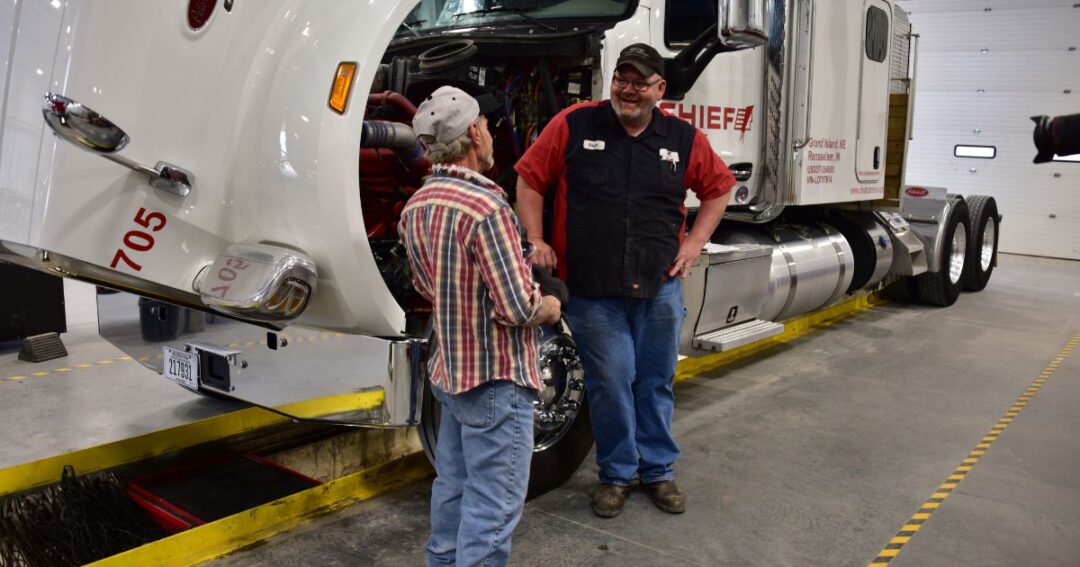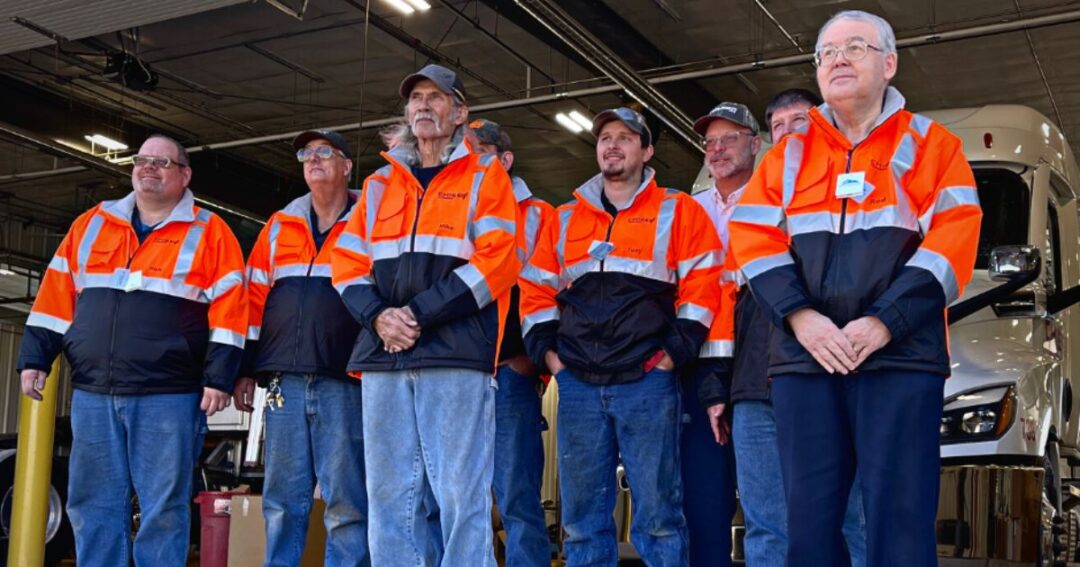Becoming a Professional Truck Driver
Welcome back to the blog extension of our “Driven Too Far” podcast. Today, we’re expanding on a topic from our latest episode, “Unlocking Your Path to Becoming a Professional Truck Driver,” a guide that’s essential for anyone considering a career in trucking.
Trucking isn’t just a job; it’s a lifestyle. And for those dreaming of joining this dynamic and challenging field, understanding the road map to success is crucial.
In the episode, we peeled back the curtain on the realities of becoming a professional truck driver, from the initial steps right through to securing your first trucking job.
The journey into trucking is a blend of commitment, learning, and adapting. It begins with meeting basic eligibility requirements and extends into choosing the right training program.
We discussed the importance of a clean driving record, the various training options available, including community colleges and company-sponsored programs, and the practicalities of balancing training with personal responsibilities.
But it’s not just about obtaining a CDL; it’s about thriving in a profession that demands skill, responsibility, and a deep understanding of the road.
Our podcast episode wasn’t just a rundown of steps; it was a comprehensive exploration of what it really takes to succeed in the trucking industry.
Eligibility and Preparations
Embarking on a trucking career starts with understanding the eligibility criteria and making the necessary preparations. It’s like preparing for a long haul; you need to ensure everything is in order before you set off.
Age Requirement for CDL: One of the first steps is meeting the age requirement for obtaining a Commercial Driver’s License (CDL). The rule of the road here is clear: you must be at least 21 years old to drive interstate. But if you’re eager to start at 18, there’s still a path forward. You can obtain your CDL and operate within your own state, giving you valuable time to gain experience before you hit the bigger roads. It’s an excellent way to gear up for the full-fledged trucking lifestyle that awaits you.
The Clean Driving Record: The next crucial criterion is your driving record. Most trucking companies seek drivers with what they term a ‘clean’ driving record. This generally means no major violations like DUIs, reckless driving incidents, or excessive speeding tickets.
However, the definition of ‘clean’ can vary between companies. Some may overlook minor infractions, considering other aspects of your profile. It’s about demonstrating responsibility and a commitment to safety, qualities that are important in the trucking world.
Subjectivity in Driving Records: It’s important to note that there’s a subjective element to what constitutes a ‘clean’ record. While major violations are often deal-breakers, lesser ones might not disqualify you. Each company weighs these factors differently, balancing their risk with the potential of giving a new driver a chance.
In summary, meeting the age and driving record requirements are your first steps in the journey to becoming a professional truck driver. Understand them well, and you set the stage for a successful entry into the world of trucking.

Training and Education
The road to becoming a professional truck driver is marked by crucial decisions, particularly when it comes to training and education. This stage is where you build the foundation of your trucking skills and knowledge.
Training Options: The journey starts with choosing the right training program. Community colleges often offer comprehensive CDL training programs, blending classroom instruction with practical driving experience. These institutions provide a structured learning environment and are known for their rigorous curriculum.
Alternatively, many trucking companies sponsor their own training programs. These company-sponsored programs can be a cost-effective way to obtain your CDL, as they often cover the training expenses in exchange for a commitment to work for the company for a specified period post-training.
Costs and Practicalities: The cost of training varies depending on the chosen route. Community college programs can range from $1,000 to $5,000, while company-sponsored programs might be free but come with a work commitment. When considering the cost, also factor in the potential for financial aid or scholarships, which some educational institutions offer.
Program Lengths and Flexibility: The duration of CDL programs can also vary. Most community college programs last between 6 to 8 weeks, with some offering part-time schedules or evening and weekend classes to accommodate those who need to balance work or family commitments while training. This flexibility is crucial for many aspiring drivers who cannot commit to a full-time program.
Choosing the right training program is a significant step in your trucking journey. It requires balancing factors like cost, time commitment, and personal circumstances to find the best fit for your career aspirations.

Classroom and Practical Training
The road to becoming a professional truck driver is paved with both classroom theory and hands-on practical training. Each plays a pivotal role in molding a competent and confident trucker.
Classroom Theory: Here’s where you’ll spend time delving into the intricate web of industry regulations and laws. It’s crucial to understand these rules, not just to pass your tests, but to ensure you’re a safe and compliant driver once you hit the road.
Topics like cargo management, safety protocols, and log-keeping are staples in the curriculum. It’s not just about driving; it’s about understanding the ecosystem you’re entering.
Hands-On Training: Then comes the part most aspiring drivers are eager for – getting behind the wheel. But before you hit the open road, you’ll start in a controlled environment, usually a large parking lot or a designated training area.
Here, you’ll learn the art of maneuvering a massive vehicle: turning, parking, and even the intricate dance of backing into loading docks. These initial experiences are safe, slow-paced, and critical for building your confidence.
On-the-Road Experience: Once you’ve mastered the basics, you’ll venture onto public roads – a significant leap. Under the watchful eye of an instructor, you’ll navigate city streets and highways, learning how to handle your truck amidst traffic, weather changes, and the unexpected challenges the road might throw at you.
This blend of classroom theory and practical training is designed to equip you with the knowledge and skills you need for a successful career in trucking. It’s a journey that demands dedication and focus, but the reward is a career filled with independence and adventure.
Testing and Certification
Once you’ve journeyed through the educational landscape of truck driving, you arrive at a critical milestone: testing and certification. This phase is your bridge from training to the open road, a gatekeeper ensuring you’re ready for the responsibilities ahead.
Testing Overview: Testing in truck driving schools is a two-pronged approach. It’s designed to rigorously assess your understanding of both theoretical and practical aspects of trucking. The process usually occurs at the tail end of your training program, serving as the final hurdle before you can proudly call yourself a certified truck driver.
Dual Nature of Testing: Firstly, there’s the written test, a comprehensive examination of your knowledge of the laws, regulations, and best practices of trucking. It’s not just about rote memorization; it’s about internalizing the principles that keep you and others safe on the road. Following the written test is the practical road test. Here, you demonstrate your ability to handle a truck in real-world scenarios, showcasing your skills in navigation, vehicle control, and adherence to safety standards.
Rapport with Instructors: A key element often overlooked is the rapport you build with your instructors during your training. These relationships can significantly ease the pressure of testing. Familiar faces and a supportive environment can transform a stressful test into an affirming validation of your skills and knowledge.
Successfully navigating these tests is a testament to your commitment and readiness to embark on a career in trucking. It’s the moment your journey transitions from theory to reality, from learning to doing.

Job Hunting and Types of Trucking Jobs
With certification in hand, the next leg of your journey is finding the right job. This step is crucial, as it shapes your trucking career path and lifestyle. Here’s how to navigate the job hunting process and understand the different types of trucking jobs available.
Job Hunting Strategies: Start by leveraging the connections you made during training. Many trucking schools have relationships with employers and can offer job placement assistance.
Attend job fairs and network with other truckers for insider tips and leads. Utilize online job portals specialized in trucking vacancies. Prepare a solid resume highlighting your training, certification, and any relevant experience, even if it’s not directly related to trucking.
Types of Trucking Jobs: The trucking world is diverse, with several job types catering to different preferences and needs.
OTR (Over-the-Road): These are long-haul jobs where you might be away from home for weeks. They often pay more due to the extended time on the road and the distances covered.
Regional: These jobs typically involve travel within a specific region, allowing for more frequent home time compared to OTR. The pay is usually a balance between OTR and local jobs.
Local: Local trucking jobs involve shorter routes, meaning you can be home daily. They’re ideal for those prioritizing family time, although they generally offer lower pay compared to OTR and regional jobs.
Balancing Income and Lifestyle: Choosing between these types hinges on balancing income expectations with lifestyle and family needs. OTR jobs might be lucrative but demanding in terms of time away from home. Local jobs offer more time with family but might not meet your financial goals. Reflect on what you value more and choose accordingly.
Navigating job hunting and understanding the types of trucking jobs available is a process of aligning your career aspirations with your personal life. Choose wisely, as this decision significantly impacts your life as a trucker.

On-the-Job Training
After securing a job, you’re not quite ready to hit the highway solo just yet. On-the-job training is a critical phase where you fine-tune your skills and get acclimatized to the realities of trucking. This period is about transforming knowledge into seasoned experience.
Orientation and Mentorship: Most trucking companies start you off with an orientation program. This is your introduction to the company’s policies, procedures, and culture. It’s also where you get paired with an experienced driver – your mentor.
This partnership is invaluable; think of it as an apprenticeship on wheels. Your mentor is not just a teacher but a window into the daily life of a trucker, offering insights and advice based on real-world experience.
Real-World Learning: During this phase, you’ll encounter a myriad of scenarios that you only touched upon in training. Learning how to interact with dispatchers, handle paperwork, manage loading and unloading, and deal with unexpected situations like breakdowns or traffic delays are all part of the curriculum.
This is hands-on learning at its finest, and it’s where you start building your confidence and decision-making skills.
Duration and Intensity: The length and intensity of on-the-job training vary by company. Typically, it can range from a few weeks to several months. The goal is to ensure you’re thoroughly prepared for solo driving. Companies prioritize safety and want to make sure you’re not just competent, but comfortable and confident in handling a rig on your own.
This training is more than just a step in your career path; it’s a rite of passage in the trucking world. It’s where you transition from a rookie with a license to a professional driver with real-world savvy.

Starting Your Trucking Career
Embarking on your trucking career is a moment filled with excitement and a sense of achievement. As you transition to solo driving, this phase marks the beginning of a new chapter in your life, one where you take full control of the wheel.
Transition to Solo Driving: The leap from training to solo driving is significant. It’s where you apply everything you’ve learned, from handling the truck to navigating routes and interacting with clients. This transition is a testament to your hard work, dedication, and skill.
It’s the moment when the training wheels come off, and you begin your journey as a fully-fledged truck driver.
Final Evaluations and Assignments: Before you’re handed the keys to your truck, you’ll undergo final evaluations. These assessments ensure you’re ready to handle the responsibilities and challenges of solo driving.
Successfully passing these evaluations leads to one of the most thrilling moments in a trucker’s career – getting assigned your own truck. It’s not just a vehicle; it’s your office, your companion on the road, and a symbol of your independence.
Words of Encouragement: To all new drivers about to start their trucking career, remember this: every seasoned trucker began where you are now. Embrace the challenges and opportunities that come your way.
Stay safe, stay curious, and always keep learning. This career is not just about driving; it’s about growing, both professionally and personally. You’re embarking on a journey that offers freedom, adventure, and the chance to be part of an essential industry.
Welcome to the open road. Welcome to your trucking career. Here’s to miles of success and stories to share down the road.
Start Building Your Path
As we pull into the final stop of this journey, let’s take a moment to look in the rear-view mirror and recap the key steps and insights we’ve covered about becoming a professional truck driver.
Firstly, we discussed the foundational requirements: being of the right age and having a clean driving record. Then, we explored the various avenues of training and education, highlighting the importance of choosing the right program that fits your needs and goals.
We discussed the intricate dance of classroom theory and practical, hands-on training, emphasizing how each plays a critical role in shaping a well-rounded trucker. The testing and certification process was our next milestone, a crucial step that validates your readiness to take on the trucking world.
Job hunting strategies and understanding the different types of trucking jobs followed, where we balanced the scales of income expectations with lifestyle choices. The on-the-job training phase was about transitioning your learned skills into real-world experience, guided by the mentorship of seasoned drivers.
Finally, we celebrated the transition to solo driving, marking the true start of your trucking career.
The journey to becoming a professional truck driver is as rewarding as it is challenging. The value of thorough training and preparation cannot be overstated – it’s the bedrock upon which a successful trucking career is built.
Safe travels, and remember, every mile driven is a story in the making.
For a more in-depth exploration of these topics and to hear more stories from the road, I invite you to listen to the full episode of “Driven Too Far: The Truth About Trucking.” You can find it on our website, as well as on Spotify, Apple Podcasts, and YouTube. Each episode is designed to give you the insights and advice you need to navigate the trucking industry’s challenges.
Andrew Winkler
Andrew Winkler is the only executive in the trucking industry willing to get in the cab and listen to you. He started out in the driver’s seat like you–loving a life on the road, missing a family at home, and yelling at dispatch over the phone. He knows how it feels to be driven too far, which is why he’s giving you the truth about trucking so you can have both your family and your career.
Interested in having Andrew Winkler appear as a guest on your show? Have a show topic idea? Want to appear as a guest on Driven Too Far? Have a question?

